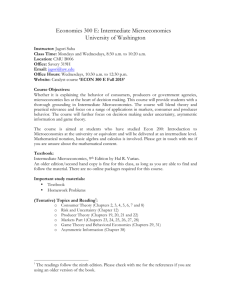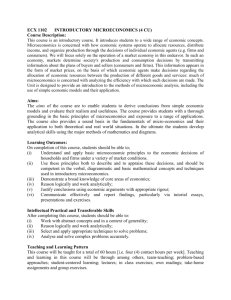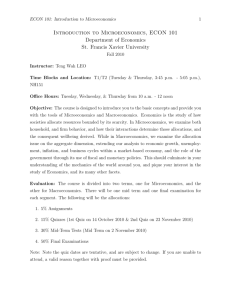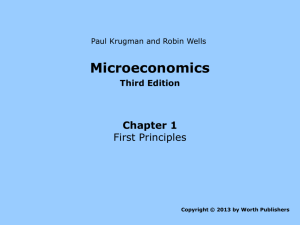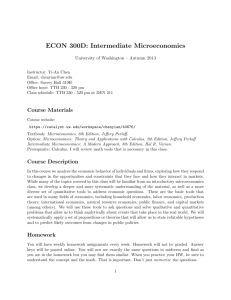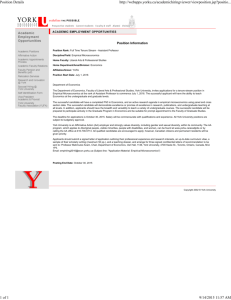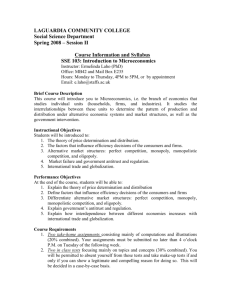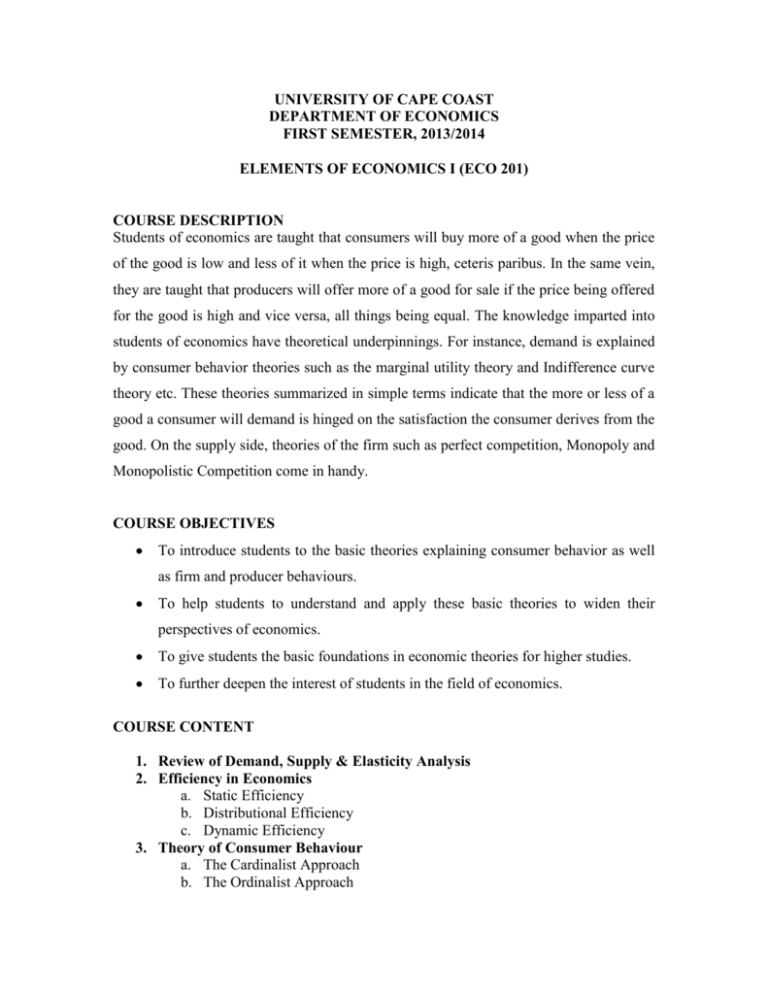
UNIVERSITY OF CAPE COAST
DEPARTMENT OF ECONOMICS
FIRST SEMESTER, 2013/2014
ELEMENTS OF ECONOMICS I (ECO 201)
COURSE DESCRIPTION
Students of economics are taught that consumers will buy more of a good when the price
of the good is low and less of it when the price is high, ceteris paribus. In the same vein,
they are taught that producers will offer more of a good for sale if the price being offered
for the good is high and vice versa, all things being equal. The knowledge imparted into
students of economics have theoretical underpinnings. For instance, demand is explained
by consumer behavior theories such as the marginal utility theory and Indifference curve
theory etc. These theories summarized in simple terms indicate that the more or less of a
good a consumer will demand is hinged on the satisfaction the consumer derives from the
good. On the supply side, theories of the firm such as perfect competition, Monopoly and
Monopolistic Competition come in handy.
COURSE OBJECTIVES
To introduce students to the basic theories explaining consumer behavior as well
as firm and producer behaviours.
To help students to understand and apply these basic theories to widen their
perspectives of economics.
To give students the basic foundations in economic theories for higher studies.
To further deepen the interest of students in the field of economics.
COURSE CONTENT
1. Review of Demand, Supply & Elasticity Analysis
2. Efficiency in Economics
a. Static Efficiency
b. Distributional Efficiency
c. Dynamic Efficiency
3. Theory of Consumer Behaviour
a. The Cardinalist Approach
b. The Ordinalist Approach
4. Theory of Firm Behaviour
a. Theory of Production
b. Theory of Cost of the Firm
c. Profit Maximization of the Firm
5. Market Structures
a. Perfect Competition
b. Monopoly
c. Monopolistic Competition
6. Introduction to Markets for Factors of Production
STUDENT LEARNING OUTCOMES
By the time you finish this course you will:
understand why diminishing marginal utility exists.
understand how a consumer goes about maximizing utility.
be able to compute the elasticity of demand for a product using the indifference
curve approach.
be able to use income elasticity to determine whether a good is inferior or normal.
know the characteristics of a perfectly competitive, monopolistic and
monopolistic competitive
market structures.
know the difference between the long-run and the short-run from a firm’s
standpoint.
understand why the marginal physical product declines when a variable input is
added to fixed inputs.
describe the short-run and long-run cost curves a firm faces.
identify when economies of scale or diseconomies of scale exist.
identify the characteristics of the three market structures.
determine how the profit maximizing quantity is determined in each of the three
market structures.
determine how the profit maximizing price quantity is determined in each of the
three market structures.
know short-run and long-run profit possibilities in each of the three market
structures.
know when firms will enter or exit the industry in each of the three market
structures.
MODE OF ASSESSMENT
1. Two Quizzes (25%)
2. One Assignment (15%)
3. One End-of-Semester Examination (60%)
ACADEMIC INTEGRITY
Please make yourself familiar with the University's policy on plagiarism and cheating and
examination impersonation. Plagiarism or any other form of cheating in examinations or
quizzes is subject to serious academic penalty.
Students will not be permitted to write make-up quizzes or hand in assignments late,
except for documented medical or compassionate reasons. Failure to take a quiz or
assignment without express permission will lead to the award of a mark of zero.
RELEVANT READING LIST
1. Bade, R. and Parkin, M. (2009): Foundations of Microeconomics, 4th Edition.
Boston: Pearson Addison Wesley.
2. Sloman, J. & Wride, A. (2009). Economics, 7th Edition, Harlow: Prentice-Hall
Inc.
3. Slavin, Stewphen L. (2008). Microeconomics, 8th Edition, New York: McGrawHill Inc.
4. Stone, Gerald W. (2008). CoreMicroeconomics, New York:Worth Publishers.
5. Arnold, Roger (2007). Microeconomics, Concise Edition, Ohio:Thomson SouthWestern.
6. Jhingan, M.L. (2007). Modern Microeconomics. Delhi: Vrinda Publications Ltd.
7. Lipsey, R. and Crystal, A. (2007). Economics. 11th Ed., Oxford University Press,
Oxford.
8. Dolan, Edwin G. (2006). Introduction to Microeconomics, 2nd Edition,
California:Best Value Textbooks, LLC.
9. Krugman, Paul, and Robin Wells (2005): Microeconomics. New York: Worth
Publishers.
10. Mankiw, Gregory (2005). Principles of Microeconomics. 4th Ed., Thompson
Publishers.
11. Frank, H. and Bernanke, B. (2004): Principles of Microeconomics,, Second
Edition. New York: McGraw-Hill.
12. Gould Jr., J. & Lazear, E. (2004). Microeconomic Theory. 6th Ed. Illinois:
Richard Irwin Inc.
th
13. McEachern, W. (2003). Microeconomics: A Contemporary Introduction. 6 Ed.
Thomson South-Western Publishers, Ohio.
14. Koutsoyiannis, A. (2002). Modern Microeconomics. 2nd Ed. MacMillan press,
London.
15. Ferguson, C.E. (). Microeconomic Theory, 3rd Ed.
16. Mansfield, E. (1997). Microeconomics. 9th Ed. New York: Norton and Co.
17. Pindyck, R.S. and Rubinfield, D.L. (1995), Microeconomics. 3rd Ed. Prentice-Hall
International Inc., New Jersey.
18. Hardwick, P., Khan, P. and Langmead, J. (1994). Modern Economics. 4th Ed.
Addison Wesley, New York.
19. Chacoliades, M. (1986), Microeconomics. Macmillan Publishing Co., New York.
20. Hirshleifer, J. (1984), Price Theory and Applications. Prentice-Hall International
Inc., London.



